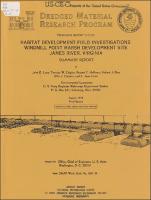Please use this identifier to cite or link to this item:
https://hdl.handle.net/11681/47567| Title: | Habitat development field investigations, Windmill Point marsh development site, James River, Virginia : summary report |
| Authors: | Lunz, John D. Zeigler, T. W. (Timothy W.) Huffman, Robert T. Diaz, R. J. (Robert J.) Clairain, Ellis J., Jr. Hunt, L. Jean |
| Keywords: | Marshes--James River (Va.) Wetlands--James River (Va.) James River (Va.) Plants Wildlife habitat improvement Dredging Dredging spoil Dredged material |
| Publisher: | U.S. Army Engineer Waterways Experiment Station |
| Series/Report no.: | Technical Report (Dredged Material Research Program (U.S.)) ; no. D-77-23 |
| Abstract: | A marsh habitat was developed using fine-textured inorganically and organically enriched sediments dredged rom the James River navigation channel in the winter of 1974-75. During the period between the autumn of 1974 and September 1977, engineering and ecological activities were accomplished to document marsh construction operations and environmental alterations that accompanied the marsh habitat development. The hydraulic construction of a relatively inexpensive sand dike on a soft river bottom foundation and the ability of the dike to contain fine-grained hydraulically dredged sediments were demonstrated. Ecological monitoring and experimental studies of plants,' soils, sediment and water quality; fish, aquatic invertebrate, and wildlife communities; and metals and chlorinated hydrocarbon compound uptake by marsh plants were also conducted. The ecological studies contrasted pre-construction and postconstruction conditions and compared postconstruction conditions with those of a natural marsh habitat. The freshwater inter-tidal, semi-contained and upland dredged material substrate was nearly completely covered with over 75 types of naturally invaded plants within about 6 months following its construction. Intertidal plantings of smooth cordgrass (Spartina alterniflora), American bulrush (Scirpus americanus), and other species, and experimental plot studies using arrow arum (Peltandra virginica), common three-square (Scirpus robustus), big cordgrass (Spartina cynosuroides) and other species were nearly completely destroyed in the autumn of 1975 as a result of Canada goose predation, erosion, or native plant invasion and competition. Seeding the upland elevations with a mixture of plant species including American beachgrass (Panicum spp.), tall fescue (Festuca elatior var. arundinacea) and ladina white clover (Trifolium repens) was moderately successful and more resistant to conditions that destroyed intertidal plantings. Postpropagation fertilization did not appear to enhance plant development on the sandy dikes. The dredged material disposal mode permitted the retention of less than half of the channel sediments pumped into the dike. The dike effluent contained high suspended loads of organic and other high cation exchange capacity sediments and suggested conditions effecting the solubilization of nitrogen forms and metals.. The channel sediments were slightly modified by the disposal operation. Natural reference marsh substrate characteristics more closely resembled those of the original channel sediments than the modified channel sediments forming the substrate of the experimental marsh. Within 2 years following its construction, an apparent chemical equilibrium had developed, and tidal chemical conditions at the natural and experimental marshes were similar. The marsh construction effected a displacement of the original shallow riverine aquatic habitat and produced a habitat of equal or greater value to the fish community. Habitat value judgements were based on observations of cover and trophic value considering macro- and meiobenthic standing crop, community structure, biomass, production and predation by the fish community during cage exclosure, fish food habit studies, and fish community censuses. The dredged material marsh also provided cover for a large variety of water-fowl, passarines, shore and wading birds, and birds of prey, which found cover and/or food on the site’s vegetated and unvegetated substrates. In a study of marsh plant uptake of metals and chlorinated hydrocarbon compounds, nickel and possibly DDE were found in higher concentrations in the experimental marsh plants compared with two natural marshes. There was no apparent relationship between total sediment chemical composition and plant available metal and chlorinated hydrocarbon compounds. Soil characteristics occurrent in marshes including near neutral pH, high organic content, and reduced oxidation reduction conditions appeared to restrict chemical mobility and bioavailability and favored chlorinated hydrocarbon degradation. Kepone was present in the experimental marsh soils at concentrations of about 500 ppb, dry weight, which exceeded Kepone levels in the natural marshes studied. Differences in Kepone levels between marsh plant tissues from the different marshes were not indicated. |
| Description: | Technical Report |
| Gov't Doc #: | Technical Report D-77-23 |
| Rights: | Approved for Public Release; Distribution is Unlimited |
| URI: | https://hdl.handle.net/11681/47567 |
| Appears in Collections: | Technical Report |
Files in This Item:
| File | Description | Size | Format | |
|---|---|---|---|---|
| Technical Report D-77-23.pdf | 5.72 MB | Adobe PDF |  View/Open |